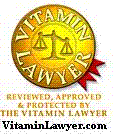FDA's Concerns When Staging a
Surprise Inspection
How to prepare
for an FDA GMP Inspection.
The Vitamin Lawyer web site,
www.vitaminlawyer.com
From Vitamin Lawyer News, www.vitainlawyernews.com
2007 Update: Outline of SOPs, other cGMP
documents
http://tinyurl.com/2eu6yj
FDA Current Good Manufacturing Practices Inspections
Increasing!
One of my clients was subjected to a 4 day
surprise FDA inspection last week and I've been in on some interesting strategy
sessions and conversations with FDA and leading industry advisors and attorneys.
[Update, several other clients have also had inspections in recent weeks,
confirming the general trend.]
It is very important for all marketers of dietary supplements to be prepared for
the increasing number of inspections, especially if you have never had one
before. Even smaller companies are beginning to be inspected, as the FDA
imposes Current Good Manufacturing Procedures (cGMPs) on the industry,
cGMP Report .htm.
The FDA position is that if you have your own label on a product, you are
responsible to see to it that the manufacturer is adhering to Good Manufacturing
Practices.
The primary concerns expressed by FDA in the post-inspection conference with my
client revolved around the requirement that the company be able to document:
1. Quality Control to assure that every product is tested upon receipt from
manufacturer
2. Complaint procedures to ensure that all adverse reactions are identified
3. Training programs for customer service and sales people
4. Disclaimers must be located at the site of the claim
5. New dietary ingredient, structure and function and health claim filings
6. Copies of labels and ads will be required to be provided.
The FDA agent in charge was particularly concerned with QC and with New Dietary
Ingredient issues, indicating that while QC currently applies to OTC products,
the new CGMPs will extend QC and complaint/adverse reaction procedures to
Dietary Supplements, Minerals and Herbs.
The good news that we can take from this is that, four years ago, when this
particular client was last inspected, the agents “came in like gangbusters” with
guns and indictment threats. This time, the agents acted respectfully,
requesting a meeting after the inspection to discuss the types of procedures and
label changes that might be needed to comply with regulations. The agent had
assimilated the Disclaimer rules created by Pearson v Shalala and
Thompson v Western States. She discussed Disclaimer issues repeatedly during
the post-inspection meeting. The attitude change was obvious to all involved,
Right to the Truth .html.
The primary lesson is that you must have written procedures in place to handle
QC, complaints and training. Secondarily, the FDA is now looking much more
closely at ingredients that may not be protected under DSHEA and expects to see
Structure & Function Notices as well as the substantiation file backing up such
notices. [Update: a couple weeks after, the inspector will issue a written
statement detailing what was observed and what samples were taken (yes, FDA will
pay for the samples). This report will be provided to the company and to
the FDA regional office for review.]
July 31, 2003 rev. 09/05/03
For information about the 2006 Adverse Event Reporting law, see:
www.aer-consultants.com
2007 Update: Outline of SOPs, other cGMP
documents
http://tinyurl.com/2eu6yj
Index |
![]()

